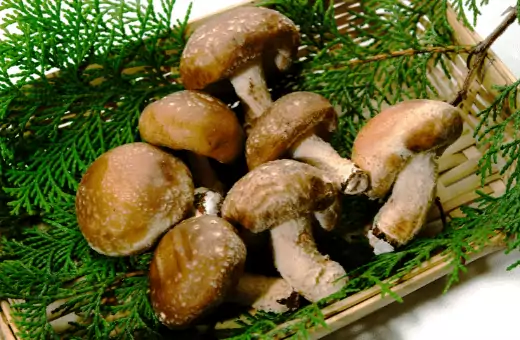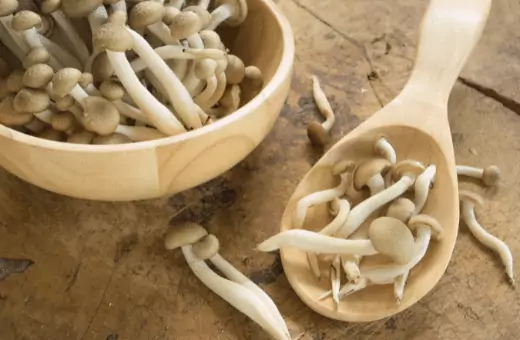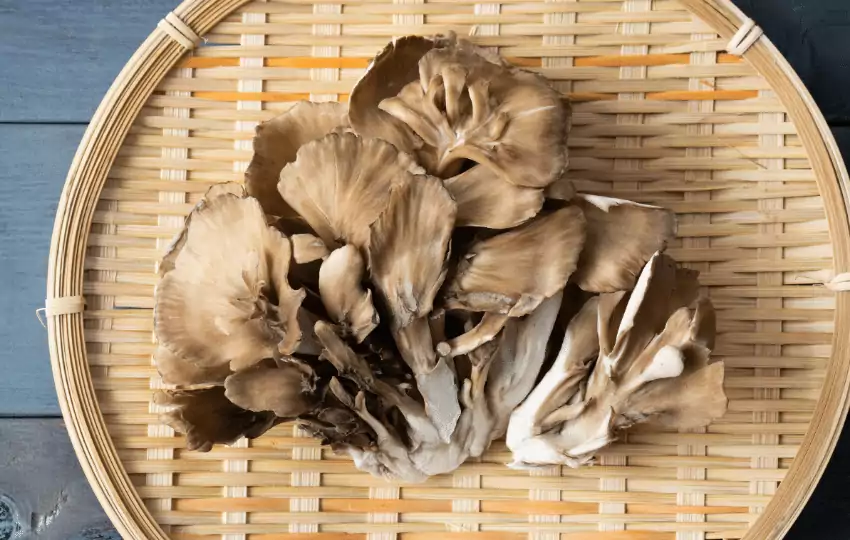Maitake mushrooms, also popular as sheep’s head mushrooms, are a type of edible fungi that belongs to the genus Grifola. These mushrooms are native to East Asia and North America and used in traditional Chinese medicine for centuries.
Maitake mushrooms are large, with a cap that can reach up to 30 cm in diameter. They have a brownish-grey color and a wrinkled surface. The flesh of these mushrooms is white or cream-coloured and has a slightly fruity smell.
The taste of maitake mushrooms is somewhat bitter. Still, they can be used in various dishes, including soups, stews, and stir-fries.
Maitake mushrooms are rich in fiber, protein, vitamins, minerals, and antioxidants. They also contain compounds that may boost the immune system and have anti-cancer properties.
Maitake mushrooms can be eaten cooked or raw. They are often used in soups, stews, stir-fries, and other dishes.
If you’re interested in trying maitake mushrooms, look for them at your local grocery store or Asian market.
Other Name: Hen-of-the-woods, Dancing mushroom, Ram’s head or Sheep’s head, and Grifola frondosa
Well, maitake mushrooms have many health benefits but are hard to find; that’s why you can use these Maitake mushroom substitutes.
7 Best Maitake Mushroom Substitutes
1. SHIITAKE MUSHROOMS- Perfect Substitute for Maitake Mushroom
Shiitake mushrooms are an excellent replacement for maitake. They are one of the most popular varieties of mushrooms in the world.
Shiitake mushrooms have a rich, savory flavor that is perfect for adding to soups, stews, and other dishes.

Shiitake mushrooms are also a useful source of several vitamins and minerals, including copper, potassium, and vitamin B6.
Other Names: Lentinula edodes
Shiitake mushrooms have been utilized in traditional Chinese medicine for millennia and their culinary applications.
Shiitake mushrooms are thought to boost the immune system, improve circulation, and help to fight off infections. Shiitake mushrooms are now widely available in fresh, dried, or supplement form.
Read More- Substitutes for Shiitake mushrooms
2. Replace KING TRUMPET MUSHROOM with Maitake mushrooms
King trumpet mushrooms, also known as Pleurotus eryngii, are a type of edible mushroom native to Mediterranean countries.
King trumpet mushrooms have a long, curved shape and a whitish-brown color. They have a mild flavor and are often used in stir-fries, soups, and stews.
Other names: French horn mushroom, king oyster mushroom, trumpet royale, aliʻi oyster, Pleurotus eryngii
King trumpet mushrooms are a good source of vitamins and minerals. They are high in vitamin D and also contain vitamins B6, riboflavin, niacin, and potassium. These mushrooms also have a high protein content.
King trumpet mushrooms have several health benefits. They have been shown to boost the immune system, improve heart health, and fight cancer.
· These mushrooms are also anti-inflammatory and can help to reduce the symptoms of arthritis.
If you are looking for a delicious and healthy way to add more mushrooms to your diet, try using king trumpet mushrooms in your next recipe!
3. SHIMEJI – A Good Alternative to Maitake Mushrooms
If you’re a fan of mushrooms, you’ve probably heard of maitake mushrooms. These mushrooms are prized for their unique flavor and their many health benefits. However, they can be hard to find and can be quite expensive.
If you’re searching for a suitable alternative to maitake mushrooms, you should check out Shimeji mushrooms.

Shimeji mushrooms are native to East Asia and have a similar appearance to maitake mushrooms. They’re also known for their distinct flavor and their many health benefits.
Suppose you’re looking for a delicious and healthy alternative to maitake mushrooms. In that case, You can use it in many ways, such as for decoration, soups, nabe, and takikomi Gohan, for making sushi or sashimi, or in various other dishes.
There are many different types of shimeji, so be sure to try a few and see which ones you like the best. Once you’ve tried shimeji, you’ll never go back to plain old rice again!
4. Easy ENOKITAKE is A Decent Replacement for Maitake Mushrooms
Enokitake mushrooms have a similar texture to maitake mushrooms, so they’ll hold up well in stir-fries and other dishes where you don’t want them to fall apart.
Enokitake also has a similar flavor, although they’re not quite as rich as maitake mushrooms.
If you can’t find maitake mushrooms, Enokitake mushrooms are a good substitute. Another name is velvet shank.
Just adjust the cooking time accordingly, as Enokitake mushrooms cook a bit faster than maitake mushrooms.
5. OYSTER MUSHROOMS- A Healthy and Easy Choice to Alternate Maitake
Oyster mushrooms are edible fungi that belong to the Pleurotus genus. They are characterized by their fan or oyster-shaped caps and white, cream, or pale yellow stems.
Oyster mushrooms are native to warm temperate and subtropical regions of the world. Still, they can also be found in cooler climates. They typically grow on dead or dying trees, stumps, logs, or paperboard.
Other Names: Hiratake, Pleurotus ostreatus
Oyster mushrooms are a healthy and easy choice to alternate shiitake and maitake. They are low in calories and fat but high in protein, fiber, vitamins, and minerals.
Oyster mushrooms also contain antioxidants and anti-inflammatory compounds that may boost your immune system and reduce your risk of chronic diseases.
Try oyster mushrooms if you’re looking for a tasty and nutritious way to add more mushrooms to your diet! You can find them fresh or canned at most grocery stores.
6. Try CHANTERELLE instead of Maitake mushroom
Chanterelle mushrooms, also known as golden chanterelles, are a variety of edible fungi that have a slightly fruity taste and a chewy texture.
· They’re often used in French cuisine, and their popularity is also growing in other parts of the world.
Other Names: golden chanterelle, girolle, Cantharellus cibarius
So, if you’re looking for a mushroom with a slightly different flavor than the typical white button mushroom, give chanterelle mushrooms a try. You might be pleasantly surprised by their unique taste.
7. PORTOBELLO MUSHROOMS – Easy Maitake Mushrooms Substitute
When it comes to finding an easy maitake mushrooms substitute, portobello mushrooms are the way to go. These large, flat mushrooms have a meaty texture that makes them perfect for grilling or roasting.
And, because they’re so adaptable, they may be used in a variety of recipes, including soups, stews, spaghetti, and pizza.
So, if you’re looking for easy maitake mushrooms to replace, portobello mushrooms are a great option.
Read More- Substitute for Golden Mushroom Soup
How to use maitake mushrooms
There are several ways to use maitake mushrooms. They can be eaten raw, cooked, or dried. They can also be prepared as tea or tincture.
Raw maitake mushrooms have a strong, earthy flavor. They can be used as a garnish on other foods or added to salads.
Cooked maitake mushrooms are milder in taste and can be used in soups, stews, and other cooked dishes.
Dried maitake mushrooms can be reconstituted in water and used in the same way as fresh mushrooms.
Maitake mushroom tea is made by simmering dried mushrooms in water for about 10 minutes. This tea can be drunk plain or sweetened with honey or sugar.
Maitake mushroom tinctures are made by soaking the mushrooms in alcohol for several weeks. These tinctures can be taken internally or applied topically.
Check More- Best substitute for Mushroom Stock Concentrate
FAQs related to Maitake Mushrooms & Its Alternatives
Q1. Maitake mushroom where to buy?
Maitake mushrooms can be seen fresh or dried in most Asian markets. You can also find them online at Amazon.com.
Q2. Maitake mushroom uses
Maitake mushrooms are most commonly used in Asian cuisine, particularly Chinese and Japanese dishes. They can be used in a variety of ways, including:
-sautéed
-stir-fried
-simmered in soup or broth
-grilled
Maitake mushrooms have a savory, slightly sweet flavor that pairs well with other ingredients commonly used in Asian cooking, such as ginger, garlic, and soy sauce.
While they are most commonly used in savory dishes, maitake mushrooms can also be used in sweet applications, such as desserts or baking.
When used in sweeter dishes, their flavor is more candy-like.
Q3. What is maitake mushroom good for?
Maitake mushrooms are popular in traditional Chinese medicine and are thought to have a range of health benefits.
· These include boosting the immune system, lowering blood pressure, and helping to control blood sugar levels.
Some people also believe that maitake mushrooms can help to fight cancer. However, there is currently
no scientific evidence to support these claims.
Maitake mushrooms are a rich source of nutrients, including vitamins, minerals, and antioxidants. They also contain a type of fiber known as beta-glucans, which is thought to boost the immune system.
For these reasons, maitake mushrooms may be a healthy addition to your diet. However, it’s essential to cook them properly to reduce the risk of food poisoning.
Q4. Is maitake the same as shiitake?
No, maitake and shiitake are not the same. Maitake is a variety of mushrooms that is native to Japan. At the same time, shiitake is a variety of mushrooms native to China.
Both mushrooms are used in cooking, but they have different flavors and textures.
Maitake mushrooms are often used in stir-fries and soups, while shiitake mushrooms are often used in stews and sauces.
Q5. Maitake mushroom, how long does it last?
Maitake mushrooms can last up to two weeks when stored in the fridge. When stored in a cool and dry place, they can last up to six months.

